
[Slide 11] Pictographs painted in red at the ends of the longhouses identified the clan of the extended family living within. This is a "Bear Clan" house; the bear, standing on all four feet, is on the wall near the porch roof. Detail view from The Village Model diorama in the Mohawk Iroquois Village, New York State Museum.

[Slide 12]The men of a longhouse - husbands who moved into the longhouses of their wives' clan and the women's brothers - were soon digging storage pits. Lined with grasses and sheets of bark, storage pits were filled with food supplies, and covered by other sheets of bark. Detail view from The Village Model diorama in the Mohawk Iroquois Village, New York State Museum.
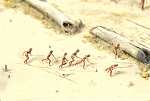
[Slide 13] Although older children assisted their mothers and fathers in various tasks, they also found time for play - boys for instance played the "hoop and javelin" game. Detail view from The Village Model diorama in the Mohawk Iroquois Village, New York State Museum.

[Slide 14] For every hour spent in building the longhouse, probably five hours had been taken up with the collection and preparation of its raw materials. Exterior view of The Iroquois Longhouse in the Mohawk Iroquois Village, New York State Museum.
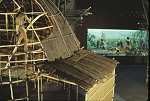
[Slide 15] A longhouse could be built in several days with the help of all the family members who would live in it - a kind of 'longhouse-raising bee.' The 'Three Sisters' diorama of an agricultural field is in the background. Exterior view of The Iroquois Longhouse in the Mohawk Iroquois Village, New York State Museum.
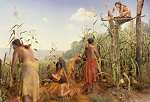
[Slide 16] The first corn of the year - "green corn" - was harvested in late summer; this was the occasion of one of the Iroquois thanksgiving ceremonies.Detail view of The `Three Sisters' diorama in the Mohawk Iroquois Village, New York State Museum.
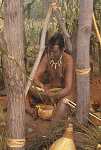
[Slide 17] An elder assisting in the harvest. In their work in the cornfields women were assisted by their older children and occasionally by elder men of their longhouse.Detail view of The `Three Sisters' diorama in the Mohawk Iroquois Village, New York State Museum.
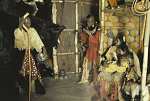
[Slide 18] Each longhouse was occupied by an extended family, all related through the mothers' side of the family. The eldest women of this extended family managed the longhouse. Detail view of The Wisdom of the Elders, set within The Iroquois Longhouse in the Mohawk Iroquois Village, New York State Museum.
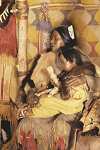
[Slide 19] A longhouse was a spacious and comfortable place for the many families who lived in the many compartments spaced down its length. Detail view of The Wisdom of the Elders, set within The Iroquois Longhouse in the Mohawk Iroquois Village, New York State Museum.

[Slide 20] Information about the interior of the longhouse has come from Iroquois oral tradition and from descriptions made by European visitors in the 1600s and 1700s. Artifacts recovered by archeologists from the sites of former villages also help to complete the inventory of objects that were used in longhouses. Detail view of The Wisdom of the Elders, set within The Iroquois Longhouse in the Mohawk Iroquois Village, New York State Museum.